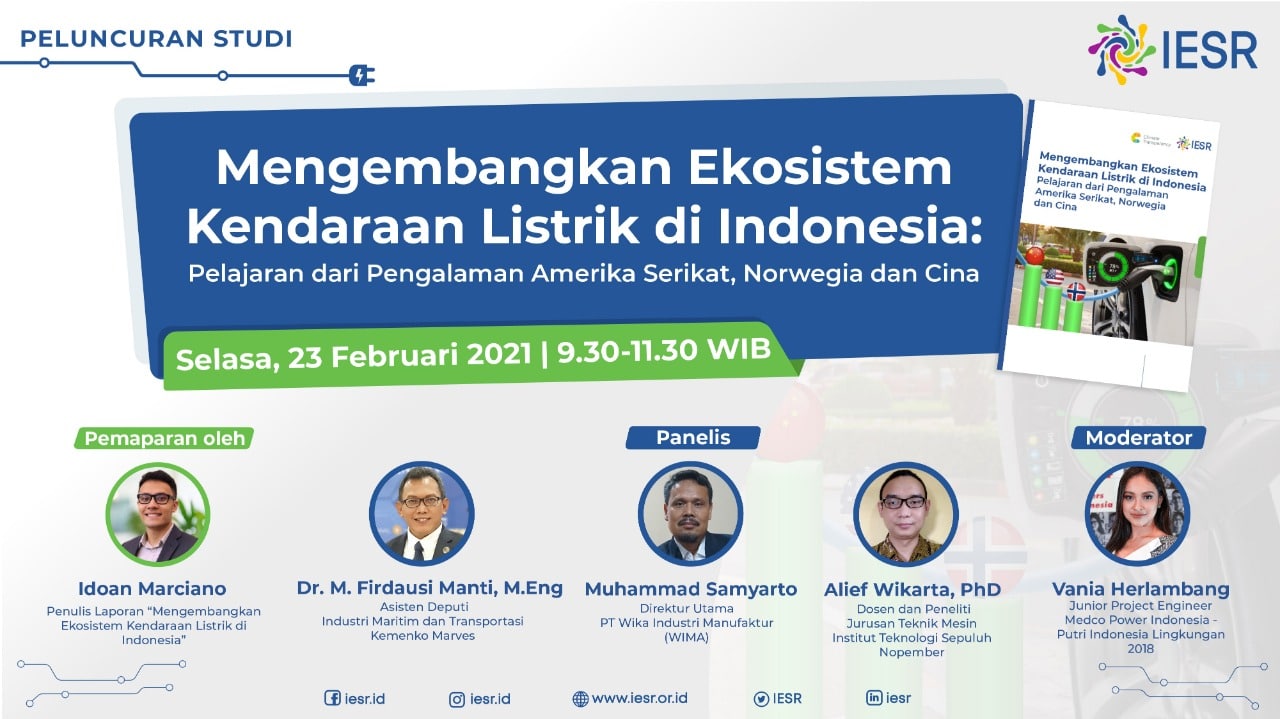Jakarta, 23 February 2021
Aligned with the Paris Agreement, Indonesia needs to prioritize reducing greenhouse gas (GHG) emissions in the transportation sector to maintain the earth’s temperature below 2oC. In Indonesia, the transportation sector consumes 45% of total final energy, of which 94% comes from vehicle fuels. Exhaust gas emissions are almost one-third of the total emissions of the energy sector.
Many countries adopted the massive and aggressive penetration of electric vehicles to reduce GHG emissions. Indeed, the source of the vehicle’s electric power must also come from renewable energy.
The Institute for Essential Services Reform (IESR) examines best practices from other countries to create an ecosystem that supports the advancement of electric vehicles in Indonesia, through a study entitled Developing an Electric Vehicle Ecosystem in Indonesia: Lessons learned from the United States, Norway, and China. More than 100 people followed the launch of the study online (23/2). IESR also invited Firdaus Manti, Assistant Deputy for Maritime and Transportation Industry of the Coordinating Ministry for Maritime and Investment Affairs, Alief Wikarta, Lecturer and Researcher of the Department of Mechanical Engineering, ITS, and Muhammad Samyarto, PT Wika Industri Manufaktur (WIMA) as responders.
Fabby Tumiwa, Executive Director of IESR, said in his opening that Indonesia has to built aggressively the proper ecosystem to support the accelerated adoption of electric vehicles in Indonesia, by learning from the experiences of comparative countries in the study.
“Sales of electric vehicles in Norway reached 54.3% in 2020 compared to only 1% in 2011. This is the result of the consistency of the Norwegian government in implementing policies to encourage the penetration of electric vehicles, “he said.
Norway is listed as the country with the highest market share for electric vehicles, which is more than 50%, while the total number of electric vehicles is around 430 thousand. Meanwhile, in 2019, China had a total of 3.4 million electric vehicles, and the United States was 1.5 million.
Indonesia itself, through the Ministry of Industry, is targeting the number of electric vehicles to reach 20% of the total vehicle production in 2025 (400,000 Low Carbon Emission Vehicles (LCEV) and 1,760,000 electric two-wheeled vehicles). However, until August 2020, there were only 2,279 roadworthy electric vehicles.
Five Undeveloped Electric Vehicle Ecosystems in Indonesia
Idoan Marciano, author of the study Developing an Electric Vehicle Ecosystem in Indonesia: Lessons learned from the United States, Norway, and China, assessing that the vehicle ecosystem in Indonesia has not been well developed, even though the government has issued Presidential Regulation No. 55/2019 which is the basis for accelerating the development of electric vehicles, but its derivative policies have not been able to increase the adoption of electric vehicles significantly.
Idoan explained that there are at least five ecosystems that need special consideration, namely a) policy, b) infrastructure/charging, c) industry/supply chain, d) public awareness, e) supply and availability of models.
“Generally, Indonesia is still lagging in all these aspects. From a financial policy perspective, Indonesia has provided various incentives but its total has only reduced about 40 percent of the price of electric vehicles after entering Indonesia. Furthermore, Indonesia also does not have regulations on fossil vehicle restriction, while the comparison countries have targeted 100 percent electric vehicles and banned conventional vehicles, “he explained.
In terms of charging infrastructure, Idoan views that the ratio of chargers to electric vehicles in Indonesia is still lower, namely 70: 1, while countries with high penetration of electric vehicles have a ratio of less than 25: 1.
As viewed from the industrial and supply chains, Indonesia also does not have the production capacity that is already operating to produce electric vehicle components, especially batteries. Meanwhile, China is capable of producing batteries up to 200 GWh / year.
Besides, people’s motivation to buy electric vehicles in Indonesia refers more to economic reasons and the availability of infrastructure, while people in comparison countries are more influenced by economic, environmental, and technological reasons.
Furthermore, Idoan found that the availability of supply and various models is also an important factor in the adoption of electric vehicles.
“In Indonesia, there are already 15 companies with production facilities for two-wheeled electric vehicles, with a total capacity of around 877 thousand units/year. In China, there are already 500 companies with a total production of more than 3.5 million units/year, ”he said.
This study recommends several strategies and policies that can be adopted by the government and all stakeholders to develop the electric vehicle ecosystem in Indonesia, as follows:
- Align the national electric vehicle adoption targets and make them binding
- Develop an integrated roadmap for the transition to electric vehicles
- Implement policies to limit the sales of fossil fuel vehicles
- Provide financial incentives (from the central government) to reduce the purchase price of electric vehicles, a minimum of about 50 percent for electric cars, for electric motorbikes only 5-10 percent more expensive than the price of conventional motorbikes.
- Provide fiscal and non-fiscal incentives (from local governments) under the conditions of their respective regions
- Impose technology transfer in collaboration with the international electric vehicle and battery manufacturers
- Issue supply-side policies, like fuel economy standard, conventional vehicles quota and to encourage production and increase the availability of electric vehicle models
- Provide grants to research and academic institutions, as well as to EV and battery manufacturers to support R&D of electric vehicles and batteries technologies
- Increase investment in domestic industrial and supply chain development of electric vehicles
- Develop a more massive public charging infrastructure network through a mandate from government entities along with the subsidies for private developers
- Electrify public transportation as an entry point for the adoption of the electric vehicle. IESR appreciates the ongoing collaboration.
- Promote electric vehicles as environmentally friendly vehicles and educate consumers on the benefits and incentives of purchasing EVs
Firdaus Manti, Assistant Deputy for Maritime Industry and Transportation at the Coordinating Ministry for Maritime and Investment Affairs, who attended the study launch webinar, said that the government will encourage and provide facilities for industry players.
“We want that Indonesia is not only a market so that we invite foreign manufacturing industries, especially four-wheelers, to be developed domestically. We also encourage hotel, retail, and small supermarket associations to provide two-wheeled public charging infrastructure, so that when shopping, they can charge their electric vehicles, “he said.
Also, he emphasized the importance of close collaboration with all stakeholders including academics, the private sector, CSOs, and even the community as consumers to realize the development of electric vehicles in Indonesia.
Alief Wikarta, Lecturer and Researcher of the Department of Mechanical Engineering in ITS viewed that IESR study can be a solution for fuel diversification. He focuses on the community awareness ecosystem which is a challenge that deserves attention.
“Most of the Indonesian consumers are aware but not care. They know that, for example, certain technologies can reduce pollution but not using these technologies. Besides, our consumers have high price sensitivity, with only a thousand different prices, people will tend to choose cheaper ones. This is a challenge that requires a marketing strategy from production and government policies, “he added. He said that Indonesia can also begin to develop a circular economy concept for battery recycling, which is one of the main components of electric vehicles.
Muhammad Samyarto, PT Wika Industri Manufaktur (WIMA), agreed on Idoan’s explanation regarding the quality of electric vehicles that are better than conventional vehicles.
“The problem of charging is just a concern. If you use an electric motor, you can manage your daily use of an electric vehicle. However, it remains a challenge for us together so that it answers people’s concerns, ”he said.




